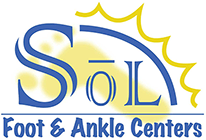 It's never normal for your child's foot to hurt. However, it can sometimes be difficult to ascertain, especially in the adolescent and preteen years.
It's never normal for your child's foot to hurt. However, it can sometimes be difficult to ascertain, especially in the adolescent and preteen years.
A foot problem that commonly occurs among adolescents and preteens is heel pain. There can be significant confusion about the cause of heel pain in children, but most commonly it results from a condition called "Sever's disease," or "calcaneal apophysitis."
Whoa! That sounds scary. I don't want my child to have a "disease" or even an "-itis!"
About Sever's Disease
While the name sounds ominous, Sever's disease is a relatively minor condition that causes heel pain in children. It typically affects girls from ages 8 to 12, while affecting boys ages 9 to 13. Children who develop Sever's disease will usually complain of pain at the very back and/or bottom of the heel.
The condition is very common in active children, especially those who play sports such as soccer, football and baseball where the use of cleats can contribute to the foot problem. It is also common problem in children that are overweight, as well as those who spend too much time wearing flat shoes and flip-flops.
Symptoms of Sever's Disease
Children who develop Sever’s disease will usually complain of heel pain located at the very back and/or bottom of the heel. The pain usually increases with activity, especially running and jumping, and decreases with rest. In some cases the pain in the heel can become so severe, that the child is limping and may not even want to bear weight on the affected foot.
Children of this age group develop the heel pain of Sever's disease because of a problem with the growth and development of the heel bones (calcaneus). Bones develop and grow from special areas called growth plates. The heel bone usually has one growth plate, which is located near the back of the heel. This growth plate separates the heel bones into a large main part, in the front, and a thin strip of bone, called "apophysitis," in the back. The apophysitis includes the part of the heel bone that contacts the ground during activity and also the part that the Achilles tendon attaches to.
During the pre-teen years, as the heel bone growth plate is beginning to close, there is often a temporary decrease in blood flow to the apophysitis part of the bone. As a result, a small injury or repetitive stress can become very painful.
Treatment for Children's Heel Pain
Treatment for Sever's disease typically starts with having the child rest from sports and activities, icing, wearing heel lifts in their shoes and calf stretching exercises. Supportive shoes are usually recommended and custom foot orthotics are often helpful to relieve the heel pain. In severe cases it may be necessary to apply a walking cast for 3 to 4 weeks.
The good news about Sever's disease is that there are many simple treatment solutions to relieve your child's heel pain, and we can help!
So don't ignore your child's heel pain - it's real! With proper treatment from a podiatrist who treats children, the pain can be minimized. Proper treatment can keep your child playing and also lessen the pain and likelihood of having the same problem on the other foot.
We welcome all ages of children as patients in our podiatry offices, and will take whatever measures possible to make them, and their parents, feel comfortable. Call (562) 433-0478 to schedule your appointment today.

